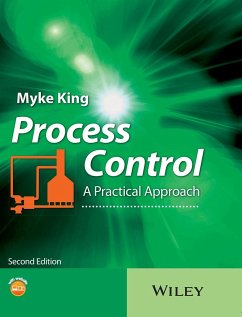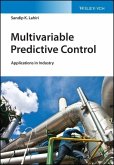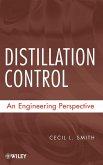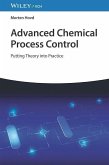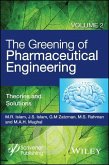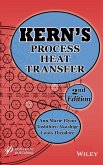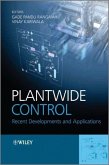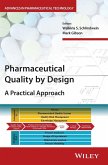Myke King
Process Control
Myke King
Process Control
- Gebundenes Buch
- Merkliste
- Auf die Merkliste
- Bewerten Bewerten
- Teilen
- Produkt teilen
- Produkterinnerung
- Produkterinnerung
This expanded new edition is specifically designed to meet the needs of the process industry, and closes the gap between theory and practice. _ Back-to-basics approach, with a focus on techniques that have an immediate practical application, and heavy maths relegated to the end of the book _ Written by an experienced practitioner, highly regarded by major corporations, with 25 years of teaching industry courses _ Supports the increasing expectations for Universities to teach more practical process control (supported by IChemE)
Andere Kunden interessierten sich auch für
![Multivariable Predictive Control Multivariable Predictive Control]() Sandip K. LahiriMultivariable Predictive Control149,99 €
Sandip K. LahiriMultivariable Predictive Control149,99 €![Distillation Control Distillation Control]() Cecil L. SmithDistillation Control111,99 €
Cecil L. SmithDistillation Control111,99 €![Advanced Chemical Process Control Advanced Chemical Process Control]() Morten HovdAdvanced Chemical Process Control83,99 €
Morten HovdAdvanced Chemical Process Control83,99 €![The Greening of Pharmaceutical Engineering, Theories and Solutions The Greening of Pharmaceutical Engineering, Theories and Solutions]() M. R. IslamThe Greening of Pharmaceutical Engineering, Theories and Solutions200,99 €
M. R. IslamThe Greening of Pharmaceutical Engineering, Theories and Solutions200,99 €![Kern's Process Heat Transfer Kern's Process Heat Transfer]() Ann Marie FlynnKern's Process Heat Transfer150,99 €
Ann Marie FlynnKern's Process Heat Transfer150,99 €![Plantwide Control Plantwide Control]() Plantwide Control172,99 €
Plantwide Control172,99 €![Pharmaceutical Quality by Design Pharmaceutical Quality by Design]() Pharmaceutical Quality by Design111,99 €
Pharmaceutical Quality by Design111,99 €-
-
-
This expanded new edition is specifically designed to meet the needs of the process industry, and closes the gap between theory and practice.
_ Back-to-basics approach, with a focus on techniques that have an immediate practical application, and heavy maths relegated to the end of the book
_ Written by an experienced practitioner, highly regarded by major corporations, with 25 years of teaching industry courses
_ Supports the increasing expectations for Universities to teach more practical process control (supported by IChemE)
Hinweis: Dieser Artikel kann nur an eine deutsche Lieferadresse ausgeliefert werden.
_ Back-to-basics approach, with a focus on techniques that have an immediate practical application, and heavy maths relegated to the end of the book
_ Written by an experienced practitioner, highly regarded by major corporations, with 25 years of teaching industry courses
_ Supports the increasing expectations for Universities to teach more practical process control (supported by IChemE)
Hinweis: Dieser Artikel kann nur an eine deutsche Lieferadresse ausgeliefert werden.
Produktdetails
- Produktdetails
- Verlag: Wiley / Wiley & Sons
- Artikelnr. des Verlages: 1W119157740
- 2. Aufl.
- Seitenzahl: 624
- Erscheinungstermin: 1. Juli 2016
- Englisch
- Abmessung: 260mm x 208mm x 38mm
- Gewicht: 1486g
- ISBN-13: 9781119157748
- ISBN-10: 1119157749
- Artikelnr.: 45189472
- Herstellerkennzeichnung
- Libri GmbH
- Europaallee 1
- 36244 Bad Hersfeld
- gpsr@libri.de
- Verlag: Wiley / Wiley & Sons
- Artikelnr. des Verlages: 1W119157740
- 2. Aufl.
- Seitenzahl: 624
- Erscheinungstermin: 1. Juli 2016
- Englisch
- Abmessung: 260mm x 208mm x 38mm
- Gewicht: 1486g
- ISBN-13: 9781119157748
- ISBN-10: 1119157749
- Artikelnr.: 45189472
- Herstellerkennzeichnung
- Libri GmbH
- Europaallee 1
- 36244 Bad Hersfeld
- gpsr@libri.de
Myke King is Director of Whitehouse Consulting which provides process control consulting and training services. He has been running courses for industry covering all aspects of process control for the past 30 years (over 150 courses to over 1,500 delegates). Myke graduated from Cambridge University in 1974 with a master's degree in Chemical Engineering. After University he joined Exxon to work as control engineer in their oil refinery in the UK, later managing the process control section. In 1983 he co-founded the consulting company KBC Process Automation, which was later sold to Honeywell. He thus has about 40 years of relevant experience - working in over 30 countries providing services to over 100 companies.
Preface x
About the Author xv
1. Introduction 1
2. Process Dynamics 3
2.1 Definition 3
2.2 Cascade Control 10
2.3 Model Identification 12
2.4 Integrating Processes 26
2.5 Other Types of Process 29
2.6 Robustness 31
3. PID Algorithm 35
3.1 Definitions 35
3.2 Proportional Action 36
3.3 Integral Action 41
3.4 Derivative Action 43
3.5 Versions of Control Algorithm 49
3.6 Interactive PID Controller 51
3.7 Proportional-on-PV Controller 56
3.8 Nonstandard Algorithms 64
3.9 Tuning 65
3.10 Ziegler-Nichols Tuning Method 66
3.11 Cohen-Coon Tuning Method 72
3.12 Tuning Based on Penalty Functions 73
3.13 Manipulated Variable Overshoot 77
3.14 Lambda Tuning Method 80
3.15 IMC Tuning Method 80
3.16 Choice of Tuning Method 83
3.17 Suggested Tuning Method for Self-Regulating Processes 84
3.18 Tuning for Load Changes 87
3.19 Tuning for SP Ramps 89
3.20 Tuning for Unconstrained MV Overshoot 91
3.21 PI Tuning Compared to PID Tuning 92
3.22 Tuning for Large Scan Interval 94
3.23 Suggested Tuning Method for Integrating Processes 97
3.24 Measure of Robustness 99
3.25 Implementation of Tuning 100
3.26 Tuning Cascades 101
3.27 Loop Gain 104
3.28 Adaptive Tuning 105
3.29 Initialisation 106
3.30 Anti-Reset Windup 108
3.31 On-Off Control 109
4. Level Control 112
4.1 Use of Cascade Control 112
4.2 Parameters Required for Tuning Calculations 113
4.3 Tight Level Control 120
4.4 Averaging Level Control 122
4.5 Error-Squared Controller 129
4.6 Gap Controller 132
4.7 Impact of Noise on Averaging Control 134
4.8 Potential Disadvantage of Averaging Level Control 136
4.9 General Approach to Tuning 137
4.10 Three-Element Level Control 139
5. Signal Conditioning 143
5.1 Instrument Linearisation 143
5.2 Process Linearisation 145
5.3 Control of pH 147
5.4 Constraint Conditioning 151
5.5 Pressure Compensation of Distillation Tray Temperature 153
5.6 Compensation of Gas Flow Measurement 153
5.7 Filtering 155
5.8 Exponential Filter 157
5.9 Nonlinear Exponential Filter 161
5.10 Moving Average Filter 161
5.11 Least Squares Filter 163
5.12 Tuning the Filter 169
5.13 Control Valve Characterisation 170
5.14 Equal Percentage Valve 172
5.15 Split-Range Valves 178
6. Feedforward Control 184
6.1 Ratio Algorithm 185
6.2 Bias Algorithm 188
6.3 Deadtime and Lead-Lag Algorithms 190
6.4 Tuning 194
6.5 Laplace Derivation of Dynamic Compensation 199
7. Deadtime Compensation 201
7.1 Smith Predictor 201
7.2 Internal Model Control 206
7.3 Dahlin Algorithm 206
8. Multivariable Control 210
8.1 Constraint Control 210
8.2 SISO Constraint Control 211
8.3 Signal Selectors 213
8.4 Relative Gain Analysis 217
8.5 Niederlinski Index 226
8.6 Condition Number 227
8.7 Steady State Decoupling 229
8.8 Dynamic Decoupling 231
8.9 MPC Principles 237
8.10 Parallel Coordinates 239
8.11 Enhanced Operator Displays 240
8.12 MPC Performance Monitoring
About the Author xv
1. Introduction 1
2. Process Dynamics 3
2.1 Definition 3
2.2 Cascade Control 10
2.3 Model Identification 12
2.4 Integrating Processes 26
2.5 Other Types of Process 29
2.6 Robustness 31
3. PID Algorithm 35
3.1 Definitions 35
3.2 Proportional Action 36
3.3 Integral Action 41
3.4 Derivative Action 43
3.5 Versions of Control Algorithm 49
3.6 Interactive PID Controller 51
3.7 Proportional-on-PV Controller 56
3.8 Nonstandard Algorithms 64
3.9 Tuning 65
3.10 Ziegler-Nichols Tuning Method 66
3.11 Cohen-Coon Tuning Method 72
3.12 Tuning Based on Penalty Functions 73
3.13 Manipulated Variable Overshoot 77
3.14 Lambda Tuning Method 80
3.15 IMC Tuning Method 80
3.16 Choice of Tuning Method 83
3.17 Suggested Tuning Method for Self-Regulating Processes 84
3.18 Tuning for Load Changes 87
3.19 Tuning for SP Ramps 89
3.20 Tuning for Unconstrained MV Overshoot 91
3.21 PI Tuning Compared to PID Tuning 92
3.22 Tuning for Large Scan Interval 94
3.23 Suggested Tuning Method for Integrating Processes 97
3.24 Measure of Robustness 99
3.25 Implementation of Tuning 100
3.26 Tuning Cascades 101
3.27 Loop Gain 104
3.28 Adaptive Tuning 105
3.29 Initialisation 106
3.30 Anti-Reset Windup 108
3.31 On-Off Control 109
4. Level Control 112
4.1 Use of Cascade Control 112
4.2 Parameters Required for Tuning Calculations 113
4.3 Tight Level Control 120
4.4 Averaging Level Control 122
4.5 Error-Squared Controller 129
4.6 Gap Controller 132
4.7 Impact of Noise on Averaging Control 134
4.8 Potential Disadvantage of Averaging Level Control 136
4.9 General Approach to Tuning 137
4.10 Three-Element Level Control 139
5. Signal Conditioning 143
5.1 Instrument Linearisation 143
5.2 Process Linearisation 145
5.3 Control of pH 147
5.4 Constraint Conditioning 151
5.5 Pressure Compensation of Distillation Tray Temperature 153
5.6 Compensation of Gas Flow Measurement 153
5.7 Filtering 155
5.8 Exponential Filter 157
5.9 Nonlinear Exponential Filter 161
5.10 Moving Average Filter 161
5.11 Least Squares Filter 163
5.12 Tuning the Filter 169
5.13 Control Valve Characterisation 170
5.14 Equal Percentage Valve 172
5.15 Split-Range Valves 178
6. Feedforward Control 184
6.1 Ratio Algorithm 185
6.2 Bias Algorithm 188
6.3 Deadtime and Lead-Lag Algorithms 190
6.4 Tuning 194
6.5 Laplace Derivation of Dynamic Compensation 199
7. Deadtime Compensation 201
7.1 Smith Predictor 201
7.2 Internal Model Control 206
7.3 Dahlin Algorithm 206
8. Multivariable Control 210
8.1 Constraint Control 210
8.2 SISO Constraint Control 211
8.3 Signal Selectors 213
8.4 Relative Gain Analysis 217
8.5 Niederlinski Index 226
8.6 Condition Number 227
8.7 Steady State Decoupling 229
8.8 Dynamic Decoupling 231
8.9 MPC Principles 237
8.10 Parallel Coordinates 239
8.11 Enhanced Operator Displays 240
8.12 MPC Performance Monitoring
Preface x
About the Author xv
1. Introduction 1
2. Process Dynamics 3
2.1 Definition 3
2.2 Cascade Control 10
2.3 Model Identification 12
2.4 Integrating Processes 26
2.5 Other Types of Process 29
2.6 Robustness 31
3. PID Algorithm 35
3.1 Definitions 35
3.2 Proportional Action 36
3.3 Integral Action 41
3.4 Derivative Action 43
3.5 Versions of Control Algorithm 49
3.6 Interactive PID Controller 51
3.7 Proportional-on-PV Controller 56
3.8 Nonstandard Algorithms 64
3.9 Tuning 65
3.10 Ziegler-Nichols Tuning Method 66
3.11 Cohen-Coon Tuning Method 72
3.12 Tuning Based on Penalty Functions 73
3.13 Manipulated Variable Overshoot 77
3.14 Lambda Tuning Method 80
3.15 IMC Tuning Method 80
3.16 Choice of Tuning Method 83
3.17 Suggested Tuning Method for Self-Regulating Processes 84
3.18 Tuning for Load Changes 87
3.19 Tuning for SP Ramps 89
3.20 Tuning for Unconstrained MV Overshoot 91
3.21 PI Tuning Compared to PID Tuning 92
3.22 Tuning for Large Scan Interval 94
3.23 Suggested Tuning Method for Integrating Processes 97
3.24 Measure of Robustness 99
3.25 Implementation of Tuning 100
3.26 Tuning Cascades 101
3.27 Loop Gain 104
3.28 Adaptive Tuning 105
3.29 Initialisation 106
3.30 Anti-Reset Windup 108
3.31 On-Off Control 109
4. Level Control 112
4.1 Use of Cascade Control 112
4.2 Parameters Required for Tuning Calculations 113
4.3 Tight Level Control 120
4.4 Averaging Level Control 122
4.5 Error-Squared Controller 129
4.6 Gap Controller 132
4.7 Impact of Noise on Averaging Control 134
4.8 Potential Disadvantage of Averaging Level Control 136
4.9 General Approach to Tuning 137
4.10 Three-Element Level Control 139
5. Signal Conditioning 143
5.1 Instrument Linearisation 143
5.2 Process Linearisation 145
5.3 Control of pH 147
5.4 Constraint Conditioning 151
5.5 Pressure Compensation of Distillation Tray Temperature 153
5.6 Compensation of Gas Flow Measurement 153
5.7 Filtering 155
5.8 Exponential Filter 157
5.9 Nonlinear Exponential Filter 161
5.10 Moving Average Filter 161
5.11 Least Squares Filter 163
5.12 Tuning the Filter 169
5.13 Control Valve Characterisation 170
5.14 Equal Percentage Valve 172
5.15 Split-Range Valves 178
6. Feedforward Control 184
6.1 Ratio Algorithm 185
6.2 Bias Algorithm 188
6.3 Deadtime and Lead-Lag Algorithms 190
6.4 Tuning 194
6.5 Laplace Derivation of Dynamic Compensation 199
7. Deadtime Compensation 201
7.1 Smith Predictor 201
7.2 Internal Model Control 206
7.3 Dahlin Algorithm 206
8. Multivariable Control 210
8.1 Constraint Control 210
8.2 SISO Constraint Control 211
8.3 Signal Selectors 213
8.4 Relative Gain Analysis 217
8.5 Niederlinski Index 226
8.6 Condition Number 227
8.7 Steady State Decoupling 229
8.8 Dynamic Decoupling 231
8.9 MPC Principles 237
8.10 Parallel Coordinates 239
8.11 Enhanced Operator Displays 240
8.12 MPC Performance Monitoring
About the Author xv
1. Introduction 1
2. Process Dynamics 3
2.1 Definition 3
2.2 Cascade Control 10
2.3 Model Identification 12
2.4 Integrating Processes 26
2.5 Other Types of Process 29
2.6 Robustness 31
3. PID Algorithm 35
3.1 Definitions 35
3.2 Proportional Action 36
3.3 Integral Action 41
3.4 Derivative Action 43
3.5 Versions of Control Algorithm 49
3.6 Interactive PID Controller 51
3.7 Proportional-on-PV Controller 56
3.8 Nonstandard Algorithms 64
3.9 Tuning 65
3.10 Ziegler-Nichols Tuning Method 66
3.11 Cohen-Coon Tuning Method 72
3.12 Tuning Based on Penalty Functions 73
3.13 Manipulated Variable Overshoot 77
3.14 Lambda Tuning Method 80
3.15 IMC Tuning Method 80
3.16 Choice of Tuning Method 83
3.17 Suggested Tuning Method for Self-Regulating Processes 84
3.18 Tuning for Load Changes 87
3.19 Tuning for SP Ramps 89
3.20 Tuning for Unconstrained MV Overshoot 91
3.21 PI Tuning Compared to PID Tuning 92
3.22 Tuning for Large Scan Interval 94
3.23 Suggested Tuning Method for Integrating Processes 97
3.24 Measure of Robustness 99
3.25 Implementation of Tuning 100
3.26 Tuning Cascades 101
3.27 Loop Gain 104
3.28 Adaptive Tuning 105
3.29 Initialisation 106
3.30 Anti-Reset Windup 108
3.31 On-Off Control 109
4. Level Control 112
4.1 Use of Cascade Control 112
4.2 Parameters Required for Tuning Calculations 113
4.3 Tight Level Control 120
4.4 Averaging Level Control 122
4.5 Error-Squared Controller 129
4.6 Gap Controller 132
4.7 Impact of Noise on Averaging Control 134
4.8 Potential Disadvantage of Averaging Level Control 136
4.9 General Approach to Tuning 137
4.10 Three-Element Level Control 139
5. Signal Conditioning 143
5.1 Instrument Linearisation 143
5.2 Process Linearisation 145
5.3 Control of pH 147
5.4 Constraint Conditioning 151
5.5 Pressure Compensation of Distillation Tray Temperature 153
5.6 Compensation of Gas Flow Measurement 153
5.7 Filtering 155
5.8 Exponential Filter 157
5.9 Nonlinear Exponential Filter 161
5.10 Moving Average Filter 161
5.11 Least Squares Filter 163
5.12 Tuning the Filter 169
5.13 Control Valve Characterisation 170
5.14 Equal Percentage Valve 172
5.15 Split-Range Valves 178
6. Feedforward Control 184
6.1 Ratio Algorithm 185
6.2 Bias Algorithm 188
6.3 Deadtime and Lead-Lag Algorithms 190
6.4 Tuning 194
6.5 Laplace Derivation of Dynamic Compensation 199
7. Deadtime Compensation 201
7.1 Smith Predictor 201
7.2 Internal Model Control 206
7.3 Dahlin Algorithm 206
8. Multivariable Control 210
8.1 Constraint Control 210
8.2 SISO Constraint Control 211
8.3 Signal Selectors 213
8.4 Relative Gain Analysis 217
8.5 Niederlinski Index 226
8.6 Condition Number 227
8.7 Steady State Decoupling 229
8.8 Dynamic Decoupling 231
8.9 MPC Principles 237
8.10 Parallel Coordinates 239
8.11 Enhanced Operator Displays 240
8.12 MPC Performance Monitoring

